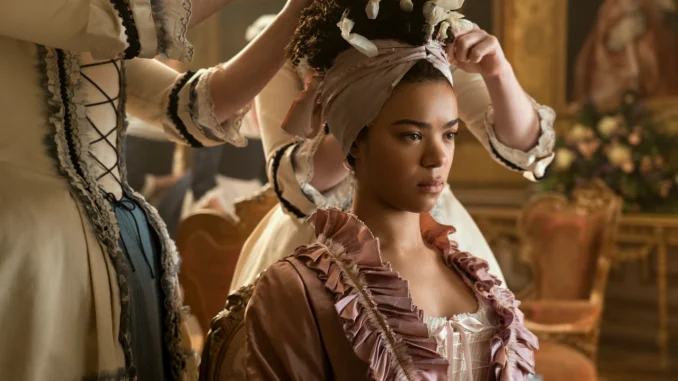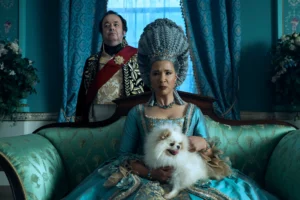
India Amarteifio plays Golda Roushevel’s younger counterpart in Queen Charlotte: A Bridgerton Story.
Bridgerton spin-off Queen Charlotte: A Bridgerton Story arrived on Netflix a little over a year ago now, adding a whole new story to the Bridgerton universe – one that didn’t feature in Julia Quinn’s novels.
Queen Charlotte delves into the earlier chapters of Queen Charlotte and King George III – the older versions of whom are played by Golda Rosheuvel and James Fleet, serving as a prequel that also features their younger counterparts, played by India Amarteifio and Corey Mylchreest.
The six-part series tells the story of how they met, fell in love and faced challenges together, including King George’s illness.
But while the character was reimagined for the Netflix period drama, Queen Charlotte is a real-life historical figure.
So who was the real Queen Charlotte? With many viewers wondering how accurate the portrayal is and whether she was actually a Black queen of England, we’ve gathered all the key information about the true story behind Queen Charlotte: A Bridgerton Story.
Who was Queen Charlotte?
Queen Charlotte was born in a castle in the Duchy of Mecklenburg-Strelitz (in present-day Germany) as the daughter of a Duke and a Princess. In 1761, the newly-crowned 22-year-old King George III decided that 17-year-old Charlotte would make a suitable wife.
She was rushed off to London, where the marriage took place on the day of her arrival at St James’s palace. (This was also the first time the bride and groom had ever met.) At the time she spoke no English – but she quickly learned the language of her new home.

Less than a year later, Charlotte gave birth to her first child: the future King George IV. In all, the couple had 15 children together, 13 of whom survived into adulthood. However, their last child, Princess Amelia (aka “Emily”), tragically died aged 27.
The couple appeared to have enjoyed a close and loving relationship. But then George III began to suffer from distressing bouts of mental illness (which led to delusions and mania). This leads to plenty of intrigue about whether the Queen or her eldest son would serve as Regent if the King became mentally unfit to rule, and it was a time of great uncertainty.
It also led to personal distress for the Queen. As her husband’s condition became more severe, it strained their marriage. From 1804 she slept separately, ate separately, and avoided seeing him alone – and after Emily’s death in 1810 he slipped further into so-called “insanity”, to the point where his eldest son George was named Prince Regent and ruled in his place.
Queen Charlotte died in 1818, and just over a year later her husband followed her to the grave.
Her personality in Bridgerton has very little to do with her personality in real life, as Golda Rosheuvel explains: “Yes, she is Queen Charlotte but she is Queen Charlotte in the world of Bridgerton. She is a creation of creator/showrunner Chris Van Dusen’s making…rich, dirty rich, addicted to snuff, devoted to her family, loves gossip and she is divinely in love with her husband who is slowly going mad.”
Was Queen Charlotte Black?
Most historians concur that it’s unlikely Queen Charlotte was considered Black or mixed-race at the time.
However, it since has been suggested that Queen Charlotte did have Black African ancestry in her family, and the creators of Bridgerton have built on this idea – by making the King’s wife a self-evidently Black woman.
Netflix tells us: “Queen Charlotte, played by Golda Rosheuvel, is widely considered to be the first mixed-race member of the British Royal family. She descended from Margarita de Castro y Sousa, a Black branch of the Portuguese Royal House.”
And Adjoa Andoh, who stars as Lady Danbury, adds: “Queen Charlotte, as some people know and some people may not know, was the descendent of Afonso III of Portugal and his African mistress, so she was mixed race. It’s very nice to see some of that history woven in.”
The idea that Queen Charlotte is “widely regarded” as mixed-race may seem like a bit of a stretch, but it does have some basis in fact – and it is a discussion among historians.
The historian Mario de Valdes y Cocom has argued that Charlotte’s ancestry can be traced back to 13th century ruler Alfonso III and his lover Madragana, who may have been a Moor (and therefore a black African). This connection to Madragana comes via Charlotte’s 15th century ancestor Margarita de Castro e Souza, a member of the Portuguese nobility, who – some assert – may have been Black.
The historian also contends that Queen Charlotte has obvious “African features” in contemporary portraits. However, this idea is also disputed, and is mired in stereotypes and racial assumptions.
